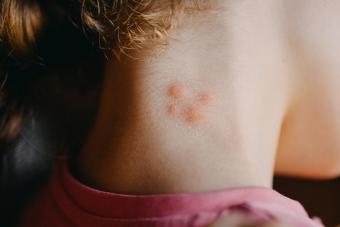Identifying Skin Rashes

Seborrheic Dermatitis

Atopic Dermatitis or Eczema

Rosacea

REQ|Flickr user hr.icio creative commons license Attribution 2.0 Generic (CC BY 2.0) Rosacea
Heat Rash

REQ|Flicker user summitcheese Creative Commons License Attribution-ShareAlike 2.0 Generic (CC BY-SA 2.0) Heat Rash
Pityriasis Rosea

Left:Aceofhearts1968/Wikimedia.org Right: Evanherk/Wikimedia.org Left: Public Domain Right: CC BY 3.0 US http://creativecommons.org/licenses/by-sa/3.0/deed.en Editorial Only Left: The herald lesion is the superior plaque on this photograph. It is located on the right lateral crural region of patient's leg. Here 3 weeks after initial discovery. “Pityriasis rosea usually begins with a large, scaly, pink patch on the chest or back, which is called a
Lichen Planus

Athlete's Foot

Chickenpox

Shingles

Left: istock Right: Thinkstock Left: Used under license Right: Used under license Left and right photos: Shingles
Measles

Scarlet Fever Rash

Staph Infection

Impetigo

Photo by Evanherk. Work found at http://en.wikipedia.org/wiki/File:Impetigo_elbow.jpg / CC BY-SA 3.0 (http://creativecommons.org/licenses/by-sa/3.0/) CC BY 3.0 US (http://creativecommons.org/licenses/by/3.0/us/) Editorial Only Impetigo elbow.jpg Photo by Evanherk. Work found at http://en.wikipedia.org/wiki/File:Impetigo_elbow.jpg / CC BY-SA 3.0 (http://creativecommons.org/licenses/by-sa/3.0/) Nederlands: krentenbaard op elleboog, eigen opname
Scabies

Left: Sven Teschke / Wikipedia Right: Sven Teschke / Wikipedia Left: CC BY 3.0 US http://creativecommons.org/licenses/by-sa/3.0/deed.en Editorial Only Right:CC BY 3.0 US http://creativecommons.org/licenses/by-sa/3.0/deed.en Editorial Only Left: Acarodermatitis (scabies) Right: Acarodermatitis (scabies)
Hand-Foot-Mouth Disease

Michael Scott / flickr CC BY 2.0 US http://creativecommons.org/licenses/by-nc/2.0/deed.en Editorial Only Sore hands (http://www.flickr.com/photos/32468442@N04/3668125349) / CC BY-NC-ND 2.0 (http://creativecommons.org/licenses/by-nc-nd/2.0/)
Lyme Disease

Fifth Disease

CDC Public Domain These are the hands of an elementary school youngster showing symptoms of erythema infectiosum, or Fifth disease. Human parvovirus B19 is the cause of erythema infectiosum, or Fifth disease, a common rash illness that is usually acquired in childhood. B19 may be transmitted through contact with infected persons, fomites, or large airborne droplets.
Ringworm

Poison Ivy, Oak or Sumac

Left: Dreamstime, Right: phil.cdc.gov Left: Used under license, Right: Public Domain Left: Poison Ivy rash ID 9984264 © Carroteater, Right: Source CDC / Richard S. Hibbits, The left elbow of this patient displayed the familiar maculopapular rash that had been caused when this man had brushed against a poison ivy plant, Toxicodendron radicans. Many native and exotic plants are poisonous to humans when ingested or if there is skin contact with plant chemicals. However, the most common problems with poisonous plants arise from contact with the sap oil of several ever-present native plants that cause an allergic skin reaction. Poison ivy, poison oak, and poison sumac release an oil, urushiol, when the leaf or other plant parts are bruised, damaged, or burned. When the oil gets on the skin an allergic reaction, referred to as contact dermatitis, occurs in most exposed people as an itchy red rash with bumps or blisters. When exposed to 50 micrograms of urushiol, an amount that is less than one grain of table salt, 80 to 90 percent of adults will develop a rash.
Hives

REQ|Flickr user Care_SMC Creative Commons License Attribution-NoDerivs 2.0 Generic (CC BY-ND 2.0) Hives
Swimmer's Itch (Cercaria Dermatitis)

Photo by Christian Fischer / Wikimedia.org Public Domain Cercarial dermatitis (
Intertrigo

Grook Da Oger / Wikimedia CC BY 3.0 US http://creativecommons.org/licenses/by-sa/3.0/deed.en Editorial Only Intergo. Surinfection sur mycose interdigitale
Drug Allergy Rash

drug allergy rash. istockphoto; image used with permission under license.
Insect Bite Rash

Brown Recluse Spider Bite

CDC.gov Public Domain - http://phil.cdc.gov/phil/details.asp Brown recluse spider bite. 4mo. after a brown recluse, L. reclusa, spider bite, this patient displayed localized tissue necrosis (see PHIL# 6265). Sometimes a bite from a brown recluse spider can go unnoticed, or maybe feel as slight as a pinprick. However, usually, after 2–8hrs, there is ensuing severe pain, erythema, and localized tissue necrosis due to the venom’s proteolytic enzymes.
Black Widow Spider Bite

http://www.flickr.com/photos/8106459@N07/ Creative commons http://creativecommons.org/licenses/by/2.0/ by David~O Black widow spider bite
Consult Your Physician








